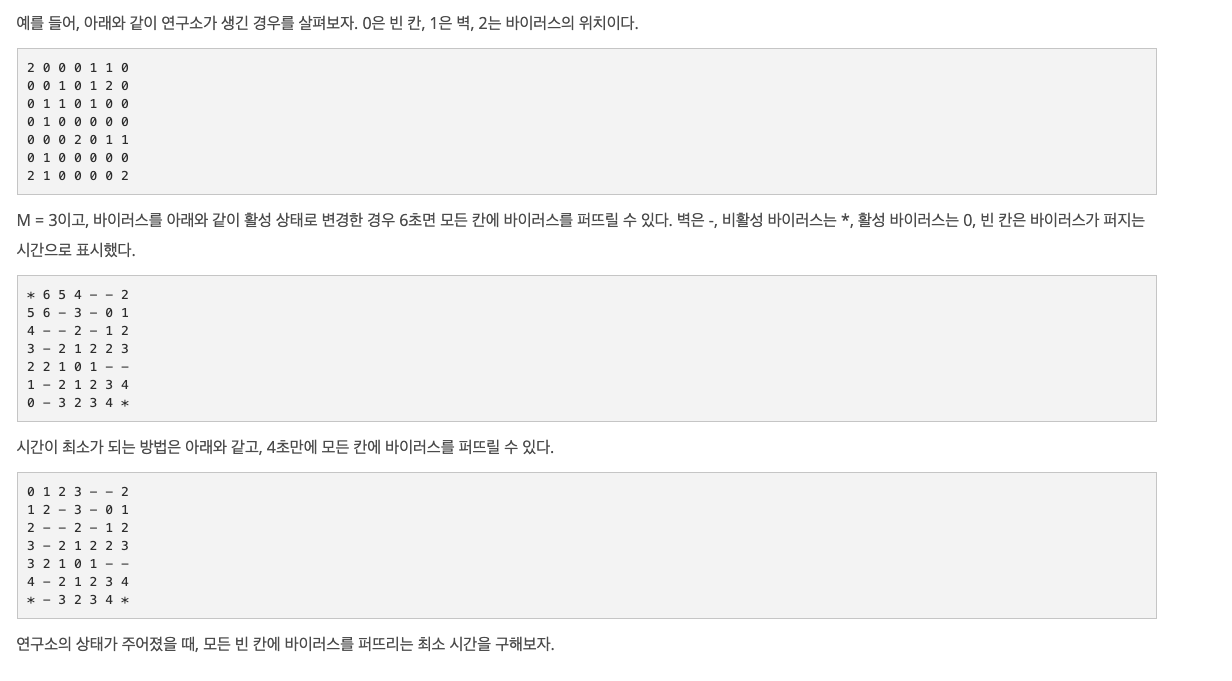#include <cstdio>
#include <vector>
#include <queue>
#include <iostream>
#include <cmath>
#include <algorithm>
#include <set>
#include <deque>
#include <numeric>
#include <map>
#define ll long long
using namespace std;
int N,M,ans=1e9;
int dx[4] = {0, 1, 0, -1};
int dy[4] = {1, 0, -1, 0};
int board[55][55];
int tmp[55][55];
int cost[55][55];
vector<pair<int,int>> virus;
int main() {
ios::sync_with_stdio(0);
cin.tie(0);
cout.tie(0);
cin >> N >> M;
for(int i=0;i<N;i++)
for(int j=0;j<N;j++)
{
cin >> board[i][j];
if(board[i][j] == 2)
virus.push_back({i,j});
}
int ch[virus.size()];
fill(ch, ch+virus.size(), 1);
for(int i=0;i<M;i++) ch[i] = 0;
do{
queue<pair<int,int>> q;
for(int i=0;i<N;i++)
{
fill(cost[i], cost[i]+N, -1);
for(int j=0;j<N;j++)
tmp[i][j] = board[i][j];
}
for(int i=0;i<virus.size();i++)
if(ch[i] == 0)
{
tmp[virus[i].first][virus[i].second] = 8;
q.push(virus[i]);
cost[virus[i].first][virus[i].second] = 0;
}
int MIN = 0;
while(!q.empty())
{
auto cur = q.front(); q.pop();
for(int dir=0;dir<4;dir++)
{
int ny = cur.first + dy[dir];
int nx = cur.second + dx[dir];
if(nx<0 or ny<0 or nx>=N or ny>=N) continue;
if(cost[ny][nx] >= 0 or tmp[ny][nx] == 1) continue;
cost[ny][nx] = cost[cur.first][cur.second] + 1;
q.push({ny,nx});
if(tmp[ny][nx] != 2)
MIN = max(MIN, cost[ny][nx]);
tmp[ny][nx] = 8;
}
}
bool flag = true;
for(int i=0;i<N;i++)
for(int j=0;j<N;j++)
{
if(cost[i][j] == -1 and tmp[i][j] != 1) {
flag = false;
goto stop;
}
}
stop:;
if(flag == true) ans = min(ans, MIN);
}while(next_permutation(ch, ch+virus.size()));
if(ans != 1e9)
cout << ans;
else
cout << -1;
return 0;
}
- 핵심
: next_permutation을 이용해서 전체 virus개수 중 M개를 선택하는 조합을 모두에 대해 전부 바이러스를 퍼뜨리는 경우 중 최소값을 기록
- 시간복잡도
- 최대
10개의 바이러스 중 5개를 선택하는 수이기 때문에 252가지 경우를 가진다
252가지 경우에 대해 BFS를 수행해서 총 252*(N^2) = 약 630,000번 연산 수행하니까 충분!


